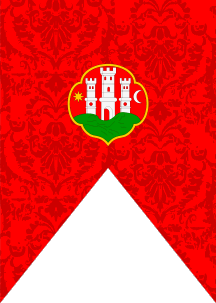
image by Željko Heimer, 10 September 2007

Last modified: 2008-07-19 by dov gutterman
Keywords: zagreb |
Links: FOTW homepage |
search |
disclaimer and copyright |
write us |
mirrors
Historical Flags of the City of Zagreb
Other Historical Flags of Zagreb
See: City of Zagreb - Subdivisions - Historical Symbols
See also:
The oldest settlement in the region of the city of Zagreb
predates the Roman era, but they are located mainly along the
Sava River. The first settlements on the southern slopes of the Medvednica
Mountain were made on the hill of Gradec (also
named Gric) with the arrival of Croats in the 7th
century.
At least since the 9th century, there are traces of the first
settlements on the nearby hill latter known as Kaptol
(the Capitol of Zagreb). There the Croato-Hungarian king
Ladislaus I (Ladislav I) established a diocese in around
1094, as is known a document from 1134 named Felitian's charter (Felicijanova
povelja), in which the Esztregon (Ostrogon) bishop Felitian
recounts on the first Zagreb bishop Duh. This is also
the oldest preserved mention of the name Zagreb.
Beneath Kaptol, south of it, a settlement of foreign
(initially Italian) merchants was created in 12th century under
the name Vicus Latinorum (Latin Street, in Croatian Vlaška
ulica, still bearing the same name) under the auspices of
the bishops of the Zagreb's Kaptol.
The merchant's city of Zagreb on the hill of Gradec was
granted the privileges of the Royal and Free City by the Golden
Bull issued by the Croato-Hungarian king Bela IV in
1242, for the services rendered in his retreat from the Tatars
hordes.
Also on the north side of Kaptol, a settlement was
granted free community status in 1344 under the name Nova Ves
(i.e. New Village), under the diocesan auspices.
Gric and Kaptol used seals since early Middle
age (14th and 15th cenrtuy) and at least for Gric is confirmed in
sources that it used red city flag in about the same time. The
Zagreb bishop Alben (Ivan) mentions in a
document of 1422 that from a belfry of the Church of St. Marcus a
"bloody flag" (vexillum cruentum) was hoisted,
so it must have been red, but regarding to its details we may
only speculate. [Leksikon], [Laszowski, 1896]
These seals were base for coats of arms, in Gric
preserved since 1499, in Kaptol after 1478 when it was
organized a "civil" municipality (the preserved coat of
arms is from 16th century). The other two "rural"
communities have no reported symbols until 19th century.
In 18th century both Gric and Kaptol maintained
military units that were eqipped with flags (some preserved in
the City Museum and the Croatian History Museum). Kapton
also had, since 17th century, flags representing its clergy (in
the Croatian History Museum).
These four communities were united in 1850 into the "Free
and Royal Capital City of Zagreb". It began growing into a
modern capital including more and more surrounding villages in
the plains towards the Sava River and beyond. The oldest parts of
the city built on the hills are today referred to as the Upper
Town (Gornji Grad).
After the World War II the city of Zagreb was administratively
divided into communities with several administrative changes over
the next years, so in 1964 Zagreb was composed of 14 communities
as basic units of local self-government. Some of these
communities adopted coats of arms (emblems) but no flag were
reported.
After Croatia attained independence in 1991, the territorial
structure of the state was changed in 1993, and the 14
communities were united into a single capital city with the
status of a county. For a short period after 1995 Zagreb gets
sepcial status within the Zagreb County, but since 1997 it is
again independant unit with the status of a county. Today, it is
divided into 17 city quarters (gradska cetvrt), although
there is no indication that these shall adopt any symbols soon.
Sources:
- Bilic, I., Ivankovic, H., ur. Zagrebacki leksikon 2, M-Ž,
Leksikografski zavod Miroslav Krleža, Zagreb, 2006. (refered
in the text as [Leksikon])
- Laszowski, E. Prilog k hrvatskoj sfragistici, in Viestnik
Hrvatskog arheološkog društva, 1895., pp. 120-136.
- Laszowski, E. Zastava grada Zagreba, in Prosvjeta, 1896. p.
223.
- Horvat, R. Prošlost grada Zagreba, Zagreb, 1942. p
410-412.
- Grad Zagreb <www.zagreb.hr>
10 October 2002.
- Gulin, A. Srednjovjekovni pecati Zagrebackog kaptola, in
Starine JAZU, vol. 58, Zagreb, 1980.
- Borošak Marijanovic, J. Zastave kroz stoljeca, Hrvatski
povijesni muzej, Zagreb, 1996.
- Peic Caldarovic, D. Heraldicki Zagreb, Hrvatski povijesni
muzej, Zagreb, 2004. (available on line at <www.hgzd.hr>)
- Cimbur, P. Natjecanje za grb, Školska knjiga, Zagreb,
1985.
- *, Univerzijada '87, Zagreb, Jugoslavija, Izvršni komitet
Univerzijade, Zagreb, 1988.
- Premerl, N. Vodic Muzeja grada Zagreba, MGZ, Zagreb, 2002.
- Muzej grada Zagreba, permanent exhibition, visited 2007.
- Bejdic, M., Državni arhiv Hrvatske, personal
communication, 2007.
- Heimer, Ž. The Flags of Zagreb, XXII International
Congress of Vexillology, FlagBerlin 2007 Legislation and
official proceedings: - Zapisnik IX. skupštine Zagreba, 3.
kolovoz 1896., Državni arhiv u Zagrebu - Zapisnik
skupštine gr. zastupstva, 4. kolovoz 1902., Državni
arhiv u Zagrebu - Zapisnik 10. sjednice IO GNO-a, 14.03.1947,
Državni arhiv u Zagrebu - Zapisnik 12. sjednice IO GNO-a,
28.03.1947, Državni arhiv u Zagrebu - Statut grada Zagreba,
29.08.1955, Sl. glasnik Narodnog odbora grada Zagreba, 13/57,
15.08.1957. - Statut grada Zagreba, 26.06.1964, Sl. glasnik grada
Zagreba, 14/64, 12.07.1964. - Statut grada Zagreba, 08.05.1968,
Sl. glasnik grada Zagreba, 8/68, 15.05.1968. - Ispravak Statuta
grada Zagreba, 27.12.1968, Sl. glasnik grada Zagreba, 22/68 -
Statut grada Zagreba (procišceni tekst), Sl. glasnik grada
Zagreba, 6/71, 20.04.1971. - Statut grada Zagreba, 30.06.1975,
Sl. glasnik grada Zagreba, 12/75, 10.07.1975. - Statut Grada
Zagreba (procišceni tekst), Sl. glasnik grada Zagreba, 8/88,
03.03.1988. - Privremeni statut Grada Zagreba, 15.04.1993, Sl.
glasnik Grada Zagreba, 9/93, 26.04.1993. - Statut Grada Zagreba,
14.12.1999, Sl. glasnik Grada Zagreba, 19/99, 14.12.1999. -
Statut Grada Zagreba (procišceni tekst), 19.12.2001, Sl.
glasnik Grada Zagreba, 20/01, 24.12.2001. - Statutarna odluka o
izmjenama i dopunama Statuta Grada Zagreba, 27.10.2005, Sl.
glasnik Grada Zagreba, 18/05, 27.10.2005. - Pravilnik o postupku
za utvrdivanje grba i zastave jedinice lokalne samouprave,
Narodne novine, br. 80/94, 26/95, Zagreb, 1994. - Pravilnik o
postupku davanja odobrenja grba i zastave jedinici lokalne
samouprave, Narodne novine, br. 94/98, Zagreb, 1998.
Legislation and official proceedings:
- Zapisnik IX. skupštine Zagreba, 3. kolovoz 1896.,
Državni arhiv u Zagrebu
- Zapisnik skupštine gr. zastupstva, 4. kolovoz 1902.,
Državni arhiv u Zagrebu
- Zapisnik 10. sjednice IO GNO-a, 14.03.1947, Državni arhiv
u Zagrebu
- Zapisnik 12. sjednice IO GNO-a, 28.03.1947, Državni arhiv
u Zagrebu
- Statut grada Zagreba, 29.08.1955, Sl. glasnik Narodnog odbora
grada Zagreba, 13/57, 15.08.1957.
- Statut grada Zagreba, 26.06.1964, Sl. glasnik grada Zagreba,
14/64, 12.07.1964.
- Statut grada Zagreba, 08.05.1968, Sl. glasnik grada Zagreba,
8/68, 15.05.1968.
- Ispravak Statuta grada Zagreba, 27.12.1968, Sl. glasnik grada
Zagreba, 22/68
- Statut grada Zagreba (procišceni tekst), Sl. glasnik grada
Zagreba, 6/71, 20.04.1971.
- Statut grada Zagreba, 30.06.1975, Sl. glasnik grada Zagreba,
12/75, 10.07.1975.
- Statut Grada Zagreba (procišceni tekst), Sl. glasnik grada
Zagreba, 8/88, 03.03.1988.
- Privremeni statut Grada Zagreba, 15.04.1993, Sl. glasnik Grada
Zagreba, 9/93, 26.04.1993.
- Statut Grada Zagreba, 14.12.1999, Sl. glasnik Grada Zagreba,
19/99, 14.12.1999.
- Statut Grada Zagreba (procišceni tekst), 19.12.2001, Sl.
glasnik Grada Zagreba, 20/01, 24.12.2001.
- Statutarna odluka o izmjenama i dopunama Statuta Grada Zagreba,
27.10.2005, Sl. glasnik Grada Zagreba, 18/05, 27.10.2005.
- Pravilnik o postupku za utvrdivanje grba i zastave jedinice
lokalne samouprave, Narodne novine, br. 80/94, 26/95, Zagreb,
1994.
- Pravilnik o postupku davanja odobrenja grba i zastave jedinici
lokalne samouprave, Narodne novine, br. 94/98, Zagreb, 1998.
Željko Heimer, 10 September 2007

image by Željko Heimer, 10 September 2007
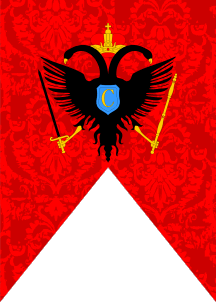
image by Željko Heimer, 10 September 2007
The oldest preserved flag of Gradec (Gric^)
- the merchant city core of the modern city - is made in the
first half of the 18th century (between 1711 and 1740). It was
made of dark red damask silk textile in shape of a rectangular
flag with split tongues. Overall ratio is about 3:4. On its
obverse is painted the city coat of arms in a cartouche: gules on
a hill vert three towers argent between a crescent and a star.
The reverse pictures the black Habsburg double-headed eagle
displayed, topped with a crown and holding a sword and a sceptre,
bearing an escutcheon azure with a cipher C or - for Carolus
VI, the Croato-Hungarian king Charles VI (Emperor Charles
III). The worn-out tails of the flag were renewed with red damask
in 18th century. [Premerl], [Leksikon]
This flag was kept in the City Hall on St. Marcus Square,
although it seems not always with the best care. Namely, in 1896,
when it was discovered in some odd corner of the Hall, it made
quite a sensation in the local journals. [Laszowski]
It was then again given a place of honour in the City Hall, where
it stood until 1907, when it was layed down in the City Museum
[Premerl] This flag was hoisted in ceremonial occasions. In
processions it was carried in front of the representatives of the
City Council. It is noted that in some ceremonial circumstances
it was hoisted from the belfry of the Church of St. Marcus –
where from it was also displayed from when the city was to be
defended from enemies [Leksikon].
It is not clear weather it is the same flag that is mentioned in
a receipt from 1740 where the city tax officer Franjo Fabijanec
notes on expenditures: "I have ceded – with the
knowledge of the lord captain – 10 pennies to the
silversmith who repaired the finial of the town's flag."
[Horvat]
Today is preserved in the Museum of the City of Zagreb, MGZ Inv.
br. 5430. The actual flag can be seen, although very small at
<www.mgz.hr>.
Borošak-Marjanovic (p.26) writes: "The first mention of
the flag of the city of Zagreb is connected with the descriptions
of the civic government from 15th century (1422) by I. K. Tkalcic
in the Historical monuments of the Free and Royal City of Zagreb,
on page L: The civic flag vexillum communis - it is the flag of
the municipality under which, in ceremonies is gathered civic
council. It was hoisted as a sign in time of armed conflicts on a
belfry of the church of St. Mark. It was coloured red, but
regarding the design we can only guess."
Željko Heimer, 10 September 2007
From: Croatian History Museum site by
courtesy of Jelena Borosak Marijanovic
Bigger image at: <jagor.srce.hr>.
:
"Flag of the Zagreb Chapter 1753, made to welcome Maria
Theresa on her visit to Zagreb
Multicoloured silk, appliques, wood, gilt bronze
244 x 244 cm, staff length 344 cm, finial 27 x 10 cm
A rectangular flag made of three parts of blue silk, edged
with interchanging white and red flame-like shapes. In the centre
of the flag field on both sides there is an iconographic
depiction of the Immaculate Virgin."
J. Borosak-Marijanovic, Zastave kroz stoljeca, Zagreb,
1996, catalogue number 10, page 98.
Just a few notes. Until the beggining of 17th century (or so),
Zagreb was actually formed by two seperate towns on two hills -
"civilian" city known as Gric< or Gradec, and
"church" city on nearby hill Kaptol (i.e. Chapter). The
mideval towns where officially separate, with different municipal
rights, until merging de facto some time in 16th century, and
latter officially too.
Anyway, this flag is the flag of the "church" city of
Kaptol formed around archbishops palace, but it is unclear to me
if it is supposed to represent the city or church government (or
something) of it.
However be it, another thought might be asked - is it coincidence
that the colours chose for the flag are red, white and blue? If
it is not, it would be one of the oldest Croatian tricolour
existing. But this is pure speculation, and Mrs. Borosak-Marijanovic
in her book doesn't give a clue for any such connection.
Željko Heimer , 28 September 1999
zg-zg86.gif)
image by Željko Heimer, 11 September 2007
After the unification of the previous independent communities
of Gric, Kaptol, Nova Ves and Vlaška ulica into the single
city in 1850, considerations about the new symbols were raised.
The city leadership contacted Bojnicic* to prepare proposals for
the coat of arms and this was forwarded to the Croatian
parliament and government at the time lead by Ban
(viceroy) Khuen-Héderváry. As noted in the city
council proceedings [Zapisnik, 1896, my translation, ZH]:
"on August 3rd, 1896, on the session of the City Assembly of
the Free and Royal Capital City of Zagreb chaired by the City
Mayor honourable Mr. Adolf Mošinski, a member of
the City Council Hudovski read the response from His
Excellency Ban of the Kingdoms of Croatia, Slavonia and Dalmatia,
informing the City Council that, based on the research lead in
that issues the coat of arms of Zagreb, is established so:
"A shield painted blue depicting on a green mount a silver
city with three towers, followed on the right with raising silver
moon and on the left a six-pointed golden star. The shield is
topped with a golden crown." (Note: literal translation, in
English heraldic terminology would be something like this: Azure
issuant from a mount vert a city walls argent with three towers
embattled of the same and in chief to dexter a crescent
increscent also argent and to sinister a mullet of six or. Atop a
crown massoned with five embattlements or, ZH)
This response was duly noted and accepted, and based on it the
article 6 of the City Statutes was amended to include these
determinations.
Since then the official colour of Zagreb becomes blue (although
this was not explicitly stated anywhere, of course). Dr. Bojnicic
prepared a drawing of this coat of arms, today preserved in the
MGZ (Inv. br. 5235) [Premerl] and in spite of all formal changes
to follow; it still serves as the most frequent model for the
depictions of the city coat of arms.
* Dr. Ivan pl. Bojnicic, head of the State Archives in Zagreb and
leading heraldic expert of its time. His best known work being
Croatian/Slavonian book of Siebmacher's armorial series [bjn99], reprint [bjn95].
Željko Heimer, 11 September 2007
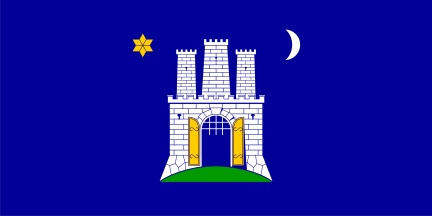
reconstruction based on description
image by Željko Heimer, 11 September 2007

reconstruction based on description
image by Željko Heimer, 11 September 2007
After the adoption of the coat of arms, for the flag one had
to wait some more years. The City Council begun considering a new
flag and in 1901 required from the Royal Land Government to
establish the design of the city flag. Ban Khuen-Héderváry
again soon answered it by forwarding a report prepared again by
Dr. Bojnicic containing two proposals for the flag.
Bojnicic obviously preferred one of them, as he names one of the
two "heraldically better and based on the good old heraldic
principles" and the other "newer and less good
version". The first proposal is a monocoloured flag with
elements of the coat of arms (i.e. without the outlining shield
– a banner of arms!), or according to Bojnicic description:
"The flag is of the same blue colour as the shield of the
city coat of arms, and one both sides have the city coat of arms
without the shied and the crown, followed in the right with a
silver raising crescent and in the left with a six pointed golden
star". The second proposal was blue-white horizontal
bicolour with the full coat of arms in the middle. [Horvat]
The Council, on the session held on May 5th, 1902 [Horvat],
apparently readily followed Bojnicic's advice favouring the
"old and better" version and it seems that the second
proposal was not even discussed. However, a member of the Council
Stjepan Timet was proposing that a red and white thin stripes be
added vertically along the hoist to highlight the national
element*, but this was not accepted. After a proposal by a
Council member Dr. Ljudevit Shwartz, Bojnicic was granted with a
formal appreciation and the city award. The Council allotted 1000
crowns for the manufacture of the flag. The city flag and the
Shwartz's proposals were adopted in the Council with 26 votes for
and 8 against. [Zapisnik, 1902] A drawing of the flag was
prepared by painter Branko Šenoa in cooperation with
Bojnicic, the original drawing being preserved in the MGZ.
[Premerl]
As a side note, it is interesting to see similar solution adopted
by Sisiak-Moslavina County flag 100
years afterwards, most certainly without any knowlage of Timet's
proposal - it is simply a similar way of thinking.
Željko Heimer, 11 September 2007

image by Željko Heimer, 13 September 2007
the flag adopted in 1902 was not manufactured immediately, and
we may only speculate why. It was on the occasion of the
coronation of the Emperor and the King Charles I (Karlo I)
in Budapest in 1916 that a richly produced ceremonial city flag
was made according to the 1902 decisions. [Leksikon]
As was noted on a piece found sewed in the flag when the flag was
being renovated in 1994, the flag was produced in the time when
mayor was Janko Holjac, and it was manufactured by
Sisters of Mercy Kvirina, Germanika, Tomislava
and Trojana after the design by Branko Šenoa.
The flag was carried in the coronation by City Council member Josip
Radakovic. [Premerl]
Thus established symbols remained in use since and they were not
changed even when the Austria-Hungary collapsed and the new
Kingdom latter to be known as Yugoslavia was established. They
were not changed in the period of the Independent State of
Croatia that was formed during the World War II.
The overall ratio of the flag is 5:7~ . The flag is produced of a
blue silk embroideried along the edges with a rich silver pattern
and containing the charges from the coat of arms in the middle.
It may be noted that the design of these charges is not of the
same artwork as the 1896 Bojnicic's coat of arms drawing, but
this is quite acceptable according to the heraldic practice - the
artwork details are irrelevant as long as they follow the blazon
to the letter. Although the base of the city seems to be
miscoloured (yellow instead of green) this may only be due to
decay of original green colouring due to the time and usage -
however I can not judge it if it is indeed so, so I leave it
yellow as it appears today. The fly and bottom edges are trimmed
with blue fringe, while the hoist and top edge have a row of
metal rings attached to it, obviously the flag was meant to be
hoisted from a staf with an arm above the flag.
The flag is today preserved in the Museum of the City of Zagreb
(MGZ Inv. br. 5430).
Željko Heimer, 13 September 2007
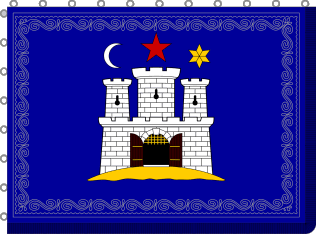
image by Željko Heimer, 14 September 2007
zg-zg47.gif)
Coat of Arms
image by Željko Heimer, 14 September 2007
The first mention of the city symbols after the World War II
in the official documents is to be found in 1947, when the
Executive Council of the City People's Committee in Zagreb (Gradski
narodni odbor u Zagrebu) adopts the proposal of the chairman
Vouk [Zapisnik 1947]: "The coat of arms of the City
People's Committee in Zagreb is composed of a blue field in which
on a green curved ground is standing a silver city with three
embattled towers with semicircular entrance with half-portcullis
and with opened doors, each tower having a keyhole-like loophole;
to its right a sic-pointed golden star and to the left a
half-moon raising. Above the shield is set a red five-pointed
star."
So, the previous crown atop the shield was replaced with a star.
Although the blazon clearly states the colours, it is not know if
the coat of arms was ever used in colours; the preserved examples
are mono-coloured.
A flag is not mentioned; although it may well be that this was
the decision that led to the adding of the star in the old flag -
namely, after the liberation of Zagreb and introduction of the
new political system, someone sewed a red five-pointed star to
the 1916 flag.
This flag was apparently used as such for some time, to be soon
stored in the MGZ. [Premerl]
The star from the flag was removed in 1994 renovation, although
the stitching in form of five-pointed star is still clearly
visible in the material (apparently, the museum conservator
expert decided that it is best to leave them visible - so the
object tells its full story).
Željko Heimer, 14 September 2007
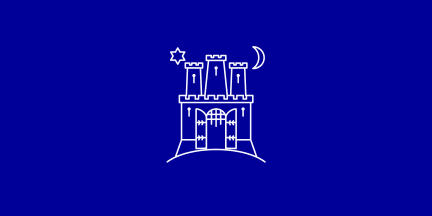
image by Željko Heimer, 17 September 2007
zg-zg64.gif)
Coat of Arms
image by Željko Heimer, 17 September 2007
After the 1947 decisions, the Statutes adopted in 1955 have
mention of neither coat of arms nor flag [Statut, 1955]. Weather
this means that the previous flag defaced with red star was about
that time layed up in the Museum, or if it was used
"silently", it is hard to say.
The Statutes to follow, adopted on 26th June 1964, introduce a
new description of coat of arms and the flag in its Article 12
[Statut, 1964]: "The city of Zagreb has its coat of arms and
its flag. The coat of arms of Zagreb is its historical coat of
arms: shield coloured blue, in which is depicted on a green mound
a silver city with three towers, a raising silver crescent to its
right and a six-pointed golden star to its left."
The flag of the city of Zagreb is also "blue as the shield
of the coat of arms of the city of Zagreb containing on both
sides the coat of arms of the city of Zagreb without the
shield."
There are no elements above the shield now. The coloured versions
were, again, apparently avoided, so is the one shown on the
covers of the Statutes. The flags were, apparently, also produced
with such white outlined depiction of the coat of arms. (And
therefore I also draw it without additional colours.)
Namely, in the second half of the 20th century a trend of
"modernization" of heraldic symbols according to the
graphical design trends in the world in general is apparent. So,
the coat of arms of Zagreb is used in simplified and stylized
versions, most often as white silhouette of the shield only. The
flags are now industrially – mass produced, to be hoisted
not only over the buildings of the city administration but also
by the city owned companies, they are hoisted as holiday
decorations on the street light poles, they are flying on
prominent positions in the city during the important events, such
as is the Zagreb Fair, on places like the Marshal Tito Square in
front of the National Theatre and the plateau in front of the
Lisinski Concert Hall. The ceremonial city flag uniquely produced
is no more.
The Statutes of 1968 only mention (in Article 9) that the city
has a coat of arms and a flag, but that the details would be
prescribed by the City Assembly [Statut, 1968], however, only
some months latter a correction to the Statutes was published,
amending the reading of the Article 9 to the text of the 1964
Statutes with additional provision that "The use of the coat
of arms and the flag is prescribed with a decision of the City
Assembly." [Ispravak, 1968]
The 1971 Statutes repeat the previous determinations literally.
[Statut, 1971]
Željko Heimer, 17 September 2007
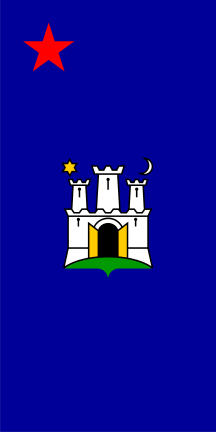
image by Željko Heimer, 20 September 2007
zg-zg75.gif)
Coat of Arms
image by Željko Heimer, 20 September 2007
The Statutes adopted on 30th June 1975 introduce rewording in
the blazon of the coat of arms, but it does not change its
contents. However, now the flag is changed with the addition of a
red star in the canton. [Statut, 1975] The same is repeated in
the 1982 [Statut, 1982] and finally 1988 Statutes (Article 6)
[Statut, 1988]: "The coat of arms of the City of Zagreb is
consisting of a blue field in a shield shape. In the middle of
the filed on a green hill is set a city with three towers and
opened city gates. In the chief part of the field on the left is
a six-pointed star and on the right is a crescent. The city with
towers and the crescent are silver, while the city doors, the
six-pointed star and the shield border are golden. The flag of
the City of Zagreb is blue. In the middle of the flag on both its
sides is the coat of arms of the City of Zagreb without the
shield. On the flag of the City of Zagreb in its top left corner
is set a red five-pointed star. With a decision of the City of
Zagreb is determined the mode of use of the coat of arms and the
flag of the City of Zagreb.
So, the colour of the doors is now explicitly mentioned (as
different from all previous post-WWII official
"blazons"). The flag is amended with a defacing red
star in the canton, although it still contains the coat of arms
elements without the shield outlining them.
This coat of arms variation is also often used in mono-coloured
depictions, and due to its simplicity and elegance it is quite
popular today as well.
The flag defaced with the star was used only in very official
circumstances, e.g. hoisted in the Assembly Hall, while the
previous versions of the flag without the star were onwards used
in general, even as newly produced flags (weather due to inertia
or ignorance of the flag maker and/or his clients or due to
intentional disregard of the new defacement?) The flags with the
red star were relatively seldom hoisted on the streets, although
there are some photos showing the flags with stars as well. I
suppose that pre-1975 flag without the star were left standing
whenever they were in decent condition and only (some) newly
displayed flags included the star.
Although it is nowhere mentioned, these flags were, as a rule,
produced so that the coat of arms elements were shown in white
only (like in the variants).
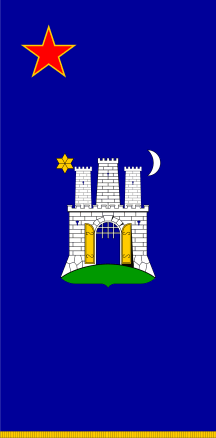
image by Željko Heimer, 20 September 2007
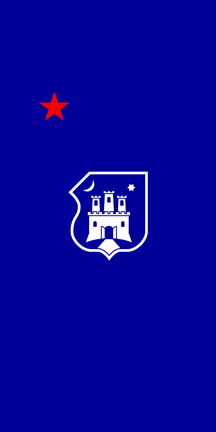
image by Željko Heimer, 20 September 2007
I have prepared drawings of two other varinats I have
documented from the book "Univerzijada '87, Zagreb,
Jugoslavija", Izvršni komitet Univerzijade, Zagreb,
1988. On photos of the city assembly in session the hall is
ornamented with a flag of the city hoisted from the inner
balcony. The two occasions that are photographed in various
periuods in late 1980's show two different flags:
- flag with coloured elements of the coat of arms without the
shield shape, defaced with a red star bordered yellow
- flag with white only depiction of the coat of arms in yet an
other variation, including the shield shape, defaced with a
smaller red star without the outline
In both cases on these photos there are three flags hoisted on
staffs next to the pulpit, at least in one of the photos the flag
of Zagreb is clearly visible like the one of the variants (see
the 4th flag here) being light
blue with white coat of arms elements without shield outline and
without the red star.
This flag was formally abandoned only with the adoption of the
1993 temporarily statutes, however, the red star defacing was in
practice dropped as soon as it was also removed from the national
flag (ie. 25th July 1990).
Željko Heimer, 20 September 2007
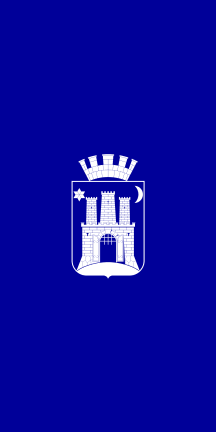
image by Željko Heimer, 23 September 2007
As already recounted, the red-star-defaced flag of Zagreb fell
into disuse in 1990, however the star-less blue flag showing
white elements of the coat of arms of Zagreb was continued in
use, as abundant as ever, or even more so. However, as there was
not regulation regarding it exact design, it seems that there
were numerous versions produced
and used
On April 15th, 1993 the Temporary statutes of the City of Zagreb
were adopted now formally replacing the symbols determined with
the 1988 Statutes. [Privremeni statut, 1993]
The Article 4 determines that the coat of arms "has the
shape of a shield coloured blue. In the filed of the shield is
set city with three towers fortified with walls and city gates.
In the chief on the left is a young moon and on the right an
eight-pointed [sic!] star. The city walls, the towers and the
young moon are silver; the eight-pointed star is golden. The hill
beneath the tower is green." Further on it is determined
that the flag is "coloured blue. In the middle on both sides
is set the coat of arms of the City of Zagreb."
This decision was obviously made hastily and contains several
inconsistencies. It is not know weather a graphical depiction of
this design was ever actually made. The eight-pointed star is
certainly unknown in the Zagreb coat of arms - although it was
apparently used in the oldest seals of Gric - it seems that it
"crept" into the design from the misunderstanding that
the old symbols of Gric are also symbols of Zagreb (as it is
indeed far to often found in literature, equalling the two
entities! It is indeed quite usual that when Zagreb before 1850
is now mentioned it was Gric that is meant).
In 1992 the City of Zagreb donated its allegedly official flag to
the collection of the Zagreb City Museum (MGZ Inv. br.5366) which
is now at display in the permanent exhibition, captioned as the
current flag of Zagreb. However that flag certainly does not
match the 1993 nor any previous determinations – the coat of
arms in that flag is white-only depiction of the 1896 Bojnicic's
design, together with the shield outline and the crown – the
most notable difference being the star that is still, of course,
six-pointed and not eight-pointed as prescribed. I can not
say that since 1992 until today I have seen this version of the
flag used anywhere else (but rather the other versions described
before).
These irregularities were resolved finally with the adopting of
the 1999 Statutes, and the current design.
Željko Heimer, 23 September 2007
On the reverse of this flag preserved in Croatian Historical
Museum there is an image of St. George slaying the dragon in
place of the shield. Under it is the inscription: 'MDCCCXXXII.',
the year (1832) when the flag was, presumably, made. This is
probably a flag of a banderium (military unit). Adopted: after
1759.
The County of Zagreb is formed on 17 July 1759, when the empress
and queen Maria Theresia granted the coat of arms, basically the
same as used in current County, in a golden baroque cartouche and
with a golden crown. Historical County of Zagreb was much larger
then the current one, mainly including the areas of current
counties of Karlovac and Sisak-Moslavina.
Source: Jelena Borošak-Marjanoviĉ: “Zastave
kroz stoljeĉa, zbirka zastava i zastavnih vrpca Hrvatskog
povjesnog muzeja”, Hrvatski povjesni muzej, Zagreb, 1996.
Željko Heimer
Ratio: 3:4~
Use: flag of the Zagreb national guard, 1848
Reverse: on the two flags of the same basic layout in Croatian
Historical Museum, the cartuche on the reverse is painted 1)
Madonna with child; 2) owl, book, hive as symbols of wisdom,
erudition and knowlage.
Inscription: embroidery 1) Obverse Za ustav i narodnu slobodu
(For constitution and national freedom), Reverse Za bratinstvo
slavjansko (For Slavic barotherhood); 2) Obverse Za
Slavjanstvo (For Slavicness), Reverse Za Slobodu (For
freedom)
Fringe: golden, all edges except hoist (not completely preserved)
Streamer: tricolour, with embroideried ornaments and
inscriptions.
Željko Heimer from FAME
The fist croatian tricolours were used by military units
organized in Zagreb area during 1848 unrests. Several flags of
this patter are preserved, differing somewhat in the details of
picture in the cartuche. The obvers is always the Coat of Arms of
the "tripple kingdom", on reverse are some alegorical
picutres. In the case of the flag on the card, on reverse is
Madonna with child. On an other flag there is a picture
containing a bee-hive, books and owl (for laboriousness, knowlege
and wisdom). In the red stripe there are broideried mottoes,
different on each side. On the two mentioed flags the mottoes
say: "For the Slavicness", "For the Freedom",
"For the Constitution and People's Freedom", "For
the Slavic Brotherhood".
This one is also available on my page mantioned above.
Željko Heimer , 13 March 2000
An other interesting detail I noticed in the Municipal Museum
of Zagreb( Muzej grada Zagreba - <www.mgz.hr>).
More or less this is stated next to the rule book in room 36 of
the Museum:
"Namely, in 1871 the Municipal Government of Zagreb issued
regulations for information in case of fire. The city was divided
into five fire districts. The location of the fire was designated
with a certain number of rounds shot from a cannon, by bell
ringing and by hoisting of a red flag - if the fire broke in the
city or a white-red flag - if the fire emerged in a village. If
the fire broke in the night, a red light was lit on the tower, or
if it was in a villiage a white one.
Željko Heimer, 23 July 2006
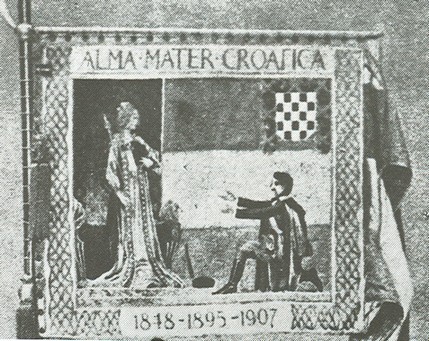
image from <www.croatianhistory.net>I
found a flag for the University of Zagreb at <www.croatianhistory.net>:
"Flag of the University of Zagreb from 1907, with Croatian
Coat of Arms"
Ron Lahav, 31 January 2008